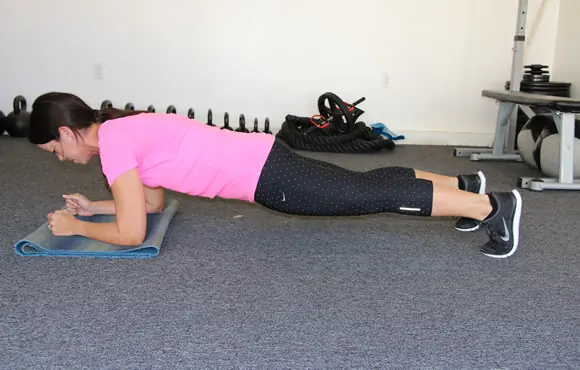When most athletes think about core-strengthening exercises, sit-ups, crunches and other traditional abdominal moves come to mind. But, this way of thinking is completely outdated and old fashioned.
For sports like running, cycling and triathlon, core training should focus on building endurance. It's not about how much weight you can lift; it's about how long you can hold the exercise to stabilize your posture.
Core endurance is the ability to maintain a low level of support the entire time you exercise to stabilize the spine. Research has proven that reduced core endurance is a predictor for future risk of low back trouble, and that muscular endurance is of greater importance than strength.
The following core endurance program, adapted from Back in Action, is designed to safely build an anatomical corset—a low-back brace—with your own muscles. These exercises can be executed without special equipment or weights; you can perform them easily on your own at home or at the gym.
All exercises should be performed with a neutral spine—keep your posture in its natural position. Your breathing pattern is also important. Don't hold your breath. Lastly, It is important to perform the core endurance exercises in the exact sequence outlined here. For more exercises and advice on protecting the spine and preventing back pain, check out Back in Action.
Front Plank
1 of 7
Form: Start in a military push-up position with a neutral spine. Rest your upper body weight on your forearms, keeping your abdominals engaged and tucked in. Don't let your lower back sag towards the floor.
Why Perform This Move: This move trains the co-activation of the abdominals, hip flexors and low back erectors all at the same time. Spinal stability is achieved by limiting movement.
Primary Muscles Trained: Transverse abdominals, hip flexors and spinal erectors.
Goal: Hold plank for 90 seconds. Perform once, or use multiple sets to increase endurance.
Side Bridge on Left and Right Sides
2 of 7
Form: Lie on your side, lining up your thighs and torso in a straight line. Lean on your forearm, keeping the upper body supported. Then, brace your abdominals and lift your torso up off the ground, balancing on just your ankles and forearm.
Primary Muscles Trained: abdominal obliques, quadratus lumborum and gluteus medius.
Goal: Hold bridge for 90 seconds. Perform once, or use multiple sets to increase endurance.
Single-Leg Back Bridge
3 of 7
Form: Lie on your back with both knees bent and your feet on the floor. Activate your abdominal muscles. Do not flatten the lower back but keep it in a curve by maintaining a neutral spine. Lift your pelvis up until your thighs are in line with your waist. Next, straighten out one knee and flex your toes upward. Avoid arching your back while performing this exercise.
Why Perform This Move: This exercise engages both the glutes and spinal erectors while challenging the abdominal muscles. The goal is to create a muscular hoop.
Primary Muscles Trained: Gluteals, hamstrings, spinal erectors, multifidus, transversus abdominals. This exercise focuses on co-activation of the front and rear of your torso.
Goal: Perform the bridge continuously for 60 seconds total (30 seconds on the left and 30 seconds on the right). Perform one set for each leg, or use multiple sets to increase endurance.
Ab Curls
4 of 7
Form: Perform an ab curl with hands tucked under your buttocks, and elbows flared out to the side and lifted upward. Keep one knee bent and the other straight with toes flexed upward. Pull your belly button inward and activate all abdominal muscles. Curl upward until your shoulder blades lift off the floor.
Try to avoid the "loaf-of-bread" posture—this is when you perform an abdominal curl up and create a protruding abdomen, which looks like a freshly baked loaf of bread. The loaf posture creates excessive intra-abdominal pressure against pain-sensitive structures in your back, elevates blood pressure, and means you're only engaging your outer most muscular wall and not engaging the deepest layers of the abdomen to help stabilize your spine.
Primary Muscles Trained: Rectus Abdominus, Transverus Abdominus.
Goal: Perform curls continuously for 60 seconds total (30 seconds on the left, 30 seconds on the right). Perform one set, or use multiple sets to increase endurance.
Point and Reach
5 of 7
Form: Get on all fours, lift one arm out in front of you, and lift the opposite leg straight out behind you. Reach both forwards and backwards at the same time, as if you were being "pulled" apart. Tighten the abdomen and hold the position.
Try touching your elbow and knee between reps and repeat for 15 seconds before switching sides.
Point and Reach con't
6 of 7
Why Perform This Move: This exercise encourages co-activation of your front abdominals, lower back erectors and hip extensors without harming the lumbar spine. It keeps the spine safe with small spinal loads: about 25 percent on the upper back side and 25 percent on the lower back side with opposite arm and legs engaged.
Primary Muscles Trained: Erector Spinae, Multifidus, Abdominals, Glutes, Hamstrings, Scapular Stabilizers.
Goal: Perform this move for 15 seconds on one side, switch arm and leg, and then repeat for 15 seconds on the other side for a total of two minutes (one minute per side).
Get ACTIVE on the Go


Couch to 5K®
The best way to get new runners off the couch and across the finish line of their first 5K.
Available for iOS | Android






Discuss This Article